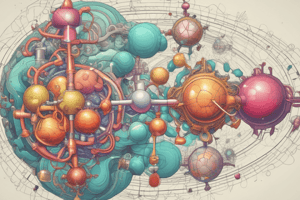Podcast
Questions and Answers
What is the average chain length for glycogen?
What is the average chain length for glycogen?
- 6-8 glucose units per chain
- 12-14 glucose units per chain (correct)
- 8-10 glucose units per chain
- 15-18 glucose units per chain
What is the main function of liver glycogen?
What is the main function of liver glycogen?
- Maintain glucose levels during fasting (correct)
- Provide energy for strenuous activity
- Store form of glucose in eukaryotic cells
- Break down glycogen to yield glucose 1-phosphate
What is the ratio of Pi:G1P at equilibrium during glycogenolysis?
What is the ratio of Pi:G1P at equilibrium during glycogenolysis?
- 1:3
- 1:1
- 1:2
- 1:4 (correct)
What is the product of the reaction catalyzed by phosphorylase during glycogenolysis?
What is the product of the reaction catalyzed by phosphorylase during glycogenolysis?
What are the two major tissues for glycogen storage?
What are the two major tissues for glycogen storage?
What is the main function of muscle glycogen?
What is the main function of muscle glycogen?
What is the structure of glycogen?
What is the structure of glycogen?
What is the product of the reaction catalyzed by phosphorylase during glycogenolysis?
What is the product of the reaction catalyzed by phosphorylase during glycogenolysis?
What is the average chain length for glycogen?
What is the average chain length for glycogen?
Which enzyme is responsible for breaking down the branches in glycogen during glycogenolysis?
Which enzyme is responsible for breaking down the branches in glycogen during glycogenolysis?
Flashcards are hidden until you start studying
Study Notes
Glycogen Structure and Function
- Glycogen has a highly branched structure, with an average chain length of 10-14 glucose residues.
- The two major tissues for glycogen storage are the liver and muscles.
Glycogenolysis
- The main function of liver glycogen is to regulate blood glucose levels.
- The main function of muscle glycogen is to provide energy for muscle contractions.
- During glycogenolysis, the enzyme phosphorylase catalyzes the reaction that breaks down glycogen to glucose-1-phosphate (G1P).
- The product of the reaction catalyzed by phosphorylase during glycogenolysis is glucose-1-phosphate (G1P).
- The enzyme responsible for breaking down the branches in glycogen during glycogenolysis is debranching enzyme.
- At equilibrium, the ratio of Pi:G1P is 1:1.
Studying That Suits You
Use AI to generate personalized quizzes and flashcards to suit your learning preferences.




